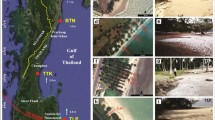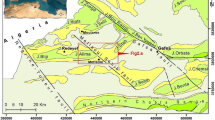Abstract
A rapid and long-traveling landslide was triggered at Aranayaka, Kegalle district, Sri Lanka on 17 May 2016 by exceptionally heavy rainfall associated with a slow-moving tropical cyclone. The precipitation that accumulated within the last 3 days from May 14 to 17 reached 446.5 mm. The landslide mass traveled over an approximately 2-km distance killing 127 people and destroying 75 houses. To deduce the failure mechanism of the Aranayaka landslide, shear behavior of two samples taken from the initial landslide area were examined through ring-shear tests. The first sample (S1) was taken from the weathered soil layer on the left scarp of the landslide. The second sample (S2) was taken from the weathered granitic gneiss at the bottom of the depression in the middle part of the landslide area. The layer was affected by intense tectonic crushing and subsequent deep weathering. A high value of shear resistance at steady state was measured on the sample S1 while the sample S2 obtained a much smaller steady state shear resistance. This indicated that the sliding surface of the landslide was located in the weathered granitic gneiss associated with the sample S2. A series of computer simulations of this landslide was then carried out given the soil parameters from the ring-shear tests and pore-water pressure ratio estimated from the rainfall records using the “SLIDE” model. In the simulation, the landslide initiated from the middle part of the source area, close to the location from where sample S2 was taken. Moreover, the time of occurrence from the simulation was similar to that observed in the real event. This is a very important information to assess further rapid landslides in areas with similar conditions. This study also indicates the importance of selecting soil samples and suggests that the ring-shear apparatus and computer simulations are effective tools to reproduce the process of landslides.










Similar content being viewed by others
References
Dang K (2015) Development of a new high-stress dynamic-loading ring-shear apparatus and its application to large-scale Landslides Doctoral Thesis, Graduate School of Engineering, Kyoto University, 79 pages
He B, Sassa K, Nagai O, Takara K (2014) Manual of LS-RAPID numerical simulation model for landslide teaching and research. Proceedings of the 1st regional symposium on landslides in the Adriatic Balkan Region, pp 193–197
JICA Survey Team (2016) 22nd May 2016, aerial survey report on inundation damages and sediment disasters
Liao Z, Hong Y, Wang J, Fukuoka H, Sassa K, Karnawati D, Fathani F (2010) Prototyping an experimental early warning system for rainfall-induced landslides in Indonesia using satellite remote sensing and geospatial datasets. Landslides 7(3):317–324
Loi DH, Quang HL, Sassa K, Takara K, Dang K, Nguyen KT, Pham VT (2017) The 28 July 2015 rapid landslide at Ha Long city, Quang Ninh, Vietnam. Landslides 14(3):1207–1215
Montarasio L, Valentino R (2008) A model for triggering mechanisms of shallow landslides. Nat Hazards Earth Syst Sci 8:1149–1159
Petley D (2016) The Aranayake landslide in Sri Lanka. AGU Blogosphere. https://blogs.agu.org/landslideblog/2016/05/19/aranayake-1/
Sassa K, He B, Miyagi T, Strasser M, Konagai K, Ostric M, Setiawan H, Takara K, Nagai O, Yamashiki Y, Tutumi S (2012) A hypothesis of the Senoumi submarine megaslide in Suruga Bay in Japan – based on the undrained dynamic-loading ring shear tests and computer simulation. Landslide 9:439–455
Sassa K, Dang K, He B, Takara K, Inoue K, Nagai O (2014a) A new high-stress undrained ring-shear apparatus and its application to the 1792 Unzen–Mayuyama megaslide in Japan. Landslides 11(5):827–842
Sassa K, He B, Dang K Q, Nagai O (2014b) Progress in landslide dynamics Landslide science for a safer geoenvironment. Proc. The Third World Landslide Forum, Springer, Vol.1, pp 37–67
Sassa K, Setiawan H, He B, Gradiški K, Dang K (2018) TXT-tool 3.081-1.5: manual for the LS-RAPID software. In: Sassa K, Tiwari B, Liu KF, McSaveney M, Strom A, Setiawan H (eds) Landslide dynamics: ISDR-ICL landslide interactive teaching tools. Springer, pp 191–224
Varnes DJ (1978) Slope movement types and processes. In: Schuster RL, Krizek RJ (eds) Landslides, analysis and control, special report 176: transportation research board. National Academy of Sciences, Washington, DC, pp 11–33
Acknowledgements
The authors would like to acknowledge the contribution of Prof. Hiroshi Fukuoka from the Research Institute for Natural Hazards and Disaster Recovery of Niigata University, Japan who joined the Aranayaka landslide investigations in Sri Lanka and gave valuable guidance on this research. Prof. Fukuoka was expected to be one of the group leaders of the planning SATREPS project but unfortunately, he passed away due to a heart attack during his landslide field trip in Bhutan in June 2018. The authors offer their deepest condolences to all of his many friends and loved ones. The authors are also very grateful to Dr. Beena Ajmera at North Dakota State University who revises the English and gives comments to improve this paper.
Author information
Authors and Affiliations
Corresponding author
Rights and permissions
About this article
Cite this article
Dang, K., Sassa, K., Konagai, K. et al. Recent rainfall-induced rapid and long-traveling landslide on 17 May 2016 in Aranayaka, Kagelle District, Sri Lanka. Landslides 16, 155–164 (2019). https://doi.org/10.1007/s10346-018-1089-7
Received:
Accepted:
Published:
Issue Date:
DOI: https://doi.org/10.1007/s10346-018-1089-7




